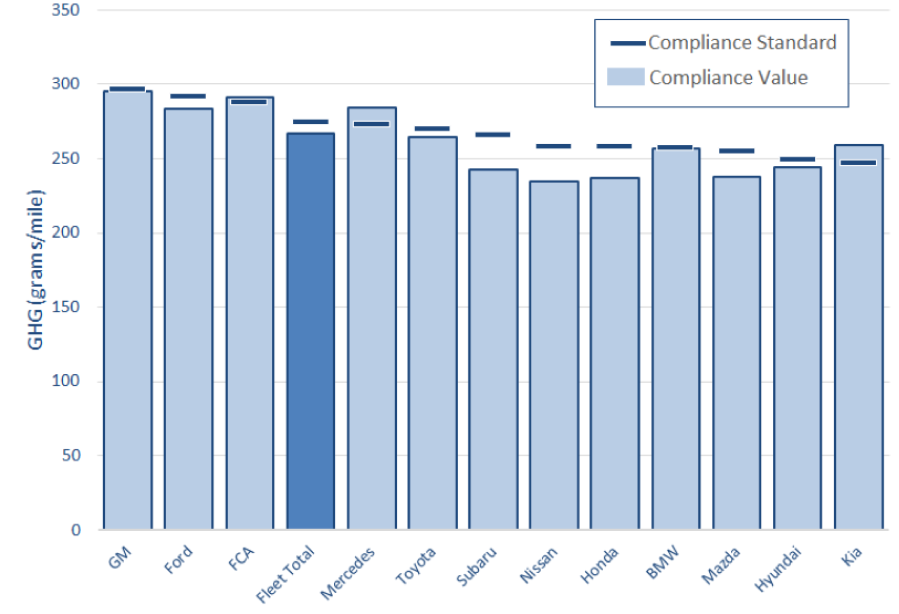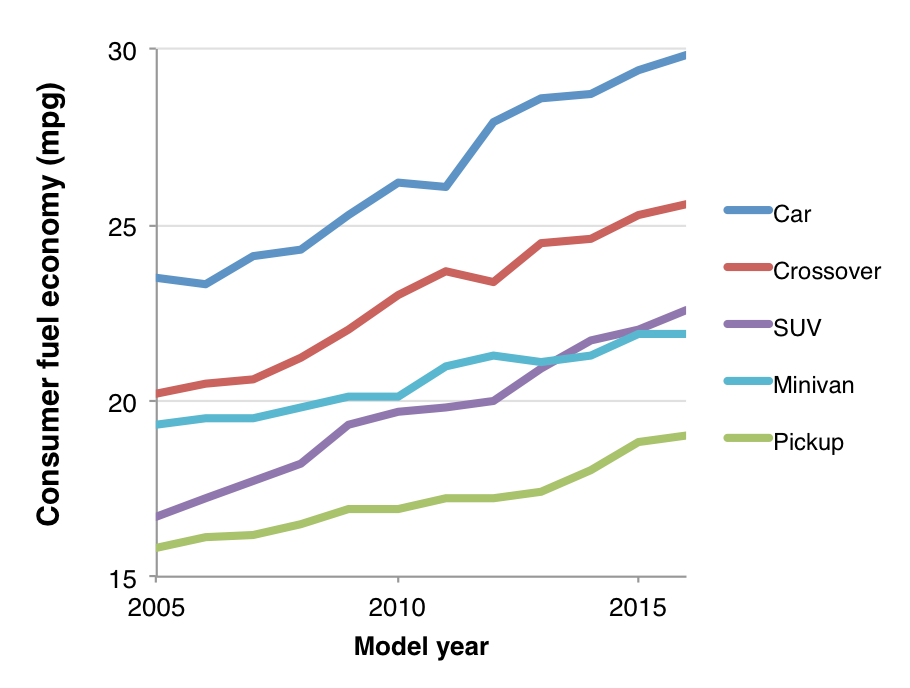Deployment of passenger car technology in Europe and the United States
Blog
Are automakers beating the U.S. vehicle fuel economy standards? Yep, bigly.
Pretty much everybody prefers a vehicle with better fuel economy than worse, all else being equal. After all, who wants to waste money on fuel? And so automakers keep touting how their cars and even larger pickup trucks are delivering higher efficiency. And better fuel economy also means we can reduce our carbon footprint without even deliberately thinking about it. We all win.
And yet we keep reading stories about automakers’ cheating on vehicle tests, misstating fuel economy in advertising, and general complaining about how the standards need to be delayed or revised. So what’s going on here? Are cars getting more efficient, or what?
The definitive data on this is the regulatory compliance data, submitted by automakers, vetted by engineers at the regulatory agencies. As I’ve observed before, any article on how the industry is doing on fuel economy that does not consult this official data is simply poor reporting. Specifically, there are two definitive reports, compiled by the EPA with data from the manufacturers: The “Manufacturer Performance Report,” which reports on the finer regulatory details, and the “Fuel Economy Trends” report, which includes a broader technology trends, back to 1975. The updated versions of these reports are hot off the virtual press, and we’ve taken a look.
What do the data tell us about automaker compliance? That the auto industry is not having trouble complying with the U.S. fuel economy and GHG standards. The industry as a whole is significantly ahead of where it’s required to be (see figure). Most individual companies beat the standards every year. General Motors, Ford, Toyota, Subaru, Nissan, Honda, BMW, Mazda, and Hyundai beat their 2015 standards. In fact, most are well ahead of the game with accumulated additional credits to carry forward into the following year. Others, like Fiat-Chrysler, Mercedes, and Kia, rely on year-to-year (internal) and company-to-company trading, but they remain in compliance. (Volkswagen is excluded from the report, as the company works through its bigger issues). Overall, here’s the lede: Regulators made standards that push the fleet to get cleaner over time, and automakers are getting it done.

Greenhouse gas emissions (gram CO2 per mile) for model year 2015 for large manufacturers (U.S. EPA Manufacturer Performance Report)
What do the data say about individual vehicle models in the market? That each vehicle type is getting more efficient. After our long period of fuel economy stagnation from 1985 to 2005, we’ve seen a lot of efficiency technology diffuse across the entire vehicle fleet. From 2005 to 2016, cars have gone from 24 to 30 mpg, crossovers have gone from 20 to 25 mpg, larger SUVs have gone from 17 to 23 mpg, minivans have increased from 19 to 22 mpg, and pickups have gone from 16 up to 19 mpg. The technologies that make all this happen include gasoline direct injection, turbocharging, cylinder deactivation, and advanced transmissions with 7+ gears. These efficiency gains are broadly distributed, delivering greater relative benefits to lower income households. In essence, this is precisely what the fuel economy and CO2 standards were supposed to do: deliver high efficiency options that fit all drivers’ needs.

Consumer fuel economy (miles per gallon) by major vehicle category for model year 2005-2016 (U.S. EPA Fuel Economy Trends Report)
What do the data suggest we should expect for the future? The U.S. EPA and DOT are in the midst of a midterm evaluation of the 2022–2025 standards. They released their Technical Assessment Report (TAR) in July this year. It’s a massive tome, made exciting (for nerds like us) by copious amounts of data on emerging technology. The gist of this new body of work is that the efficiency and CO2 standards for 2022–2025 model years are built on a strong technical foundation and can be met with cost-effective technologies (contrary to what some groups contend…).
Essentially, all this goes to show that low-cost efficiency technology keeps entering the auto market, and automakers keep beating the efficiency standards. Luckily, there is every reason to believe we’ll continue to see increasing efficiency trend through 2025 and perhaps beyond. And that is good news, because recent trends make it plain that the transport sector has its work cut out for it on reducing its carbon footprint.
